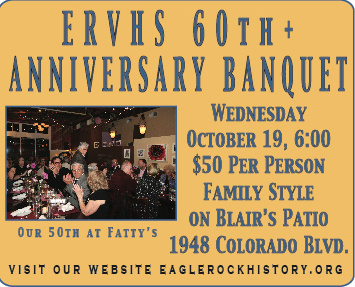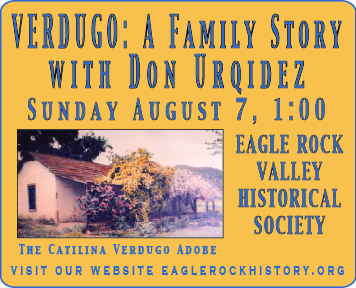Past Events

Come celebrate the 61 years of the Eagle Rock Valley Historical Society.
PLEASE R.S.V.P. TO
WEBMASTER@EAGLEROCKHISTORY.ORG
by Monday October 17th
to secure your spot at the table
with your name(s) and number in your party
PLEASE PAY EITHER:
- via PayPal to k8ttaylor@gmail.com
OR - by exact change and/or check at Blair’s the night of the party! ($50 cash or check made out to ERVHS)

JOIN US on Sunday August 7th at 1pm when we welcome Don as our virtual presenter in lieu of our Ice Cream Social; again postponed due to the Covid closure of the Center for the Arts and our concerns for our extended family. This will be a fascinating exploration of the Verdugo family’s history and continuing legacy in Southern California. Feel free to attend the virtual presentation with your own bowl or cone of ice cream to enjoy as we all listen to the presentation together!
Meeting Recording:
https://occidental.zoom.us/rec/share/QW1eSfSoEu8lG332KrTm_IWekZnH7VCkt-3_9s8JVGwnjywyWwsZY0Jo8V7d39j4.cR_BeXSLw3GY_-sf
Access Passcode: 02*l4D&F
We will take a Zoom tour along Colorado Boulevard and look into the auto facilities past and present along the route.
Although Eagle Rock’s development was made possible by the construction of the L.A. Railway in 1906, our long romance with the automobile began soon after. Beginning as a rich man’s plaything, the car increasingly became an everyday desire and necessity for life in far-flung Los Angeles. The privacy and convenience of the personal car overshadowed and eventually totally replaced the extensive local and interurban rail networks that made Los Angeles’ development possible.
Countering this concentration of auto services was the desire by many to re-emphasize the hometown services provided by the Boulevard. Efforts were made to encourage pedestrian oriented businesses. The revitalization of the Boulevard occurred but paradoxically, the primary means of access to these businesses continued to be the private car. Fuel and mechanical services thus remained a vital part of the urban mix.
Our tour guide: Eric Warren
California history, especially that of its other regions, is much older, and features a more diverse cast of protagonists, than just about any other part of the United States. Attend our meeting and hear Brian Dervin Dillon discuss early California.
Zoom Meeting with Brian Dervin Dillon
Meeting ID: 894 3051 0378
Passcode: 15421900
Meeting ID: 874 8555 3802
Passcode: 196110
60 Years of Collecting & Protecting! Happy Anniversary to Us!
This is an important moment to pause and celebrate the accomplishments of our organization and to take a look at how we got here. Eric Warren, our current Vice President and author of several books on the history of the area, will present a visual history of the Eagle Rock Valley Historical Society.
Who was at the heart of our institutional origins?
Who were the early movers and shakers of the community who made it all come to fruition?
What were the ups and downs of the Society’s past and was there a moment when all felt lost?
Your questions need answers and all will get covered in this meeting!
What exactly is an asylum and/or a sanatorium? And a feminist one at that? What does that mean exactly? Where the heck is Rockhaven? Let’s get it all straightened out together!
Zoom link
Meeting ID: 880 7808 0226
Passcode: 90041
Historic Transportation Through Eagle Rock
From the beginnings of its suburbanization, issues of connectivity to the cities around it drove the process. The initial connection of concern was the Eagle Rock Boulevard corridor, where swampy areas around York Boulevard blocked access to LA. Very soon after, the east-west connection between our valley and adjacent cities and thence the San Fernando and San Gabriel Valleys, became the focus of both local boosters and State and regional planners. While this did benefit Eagle Rock, it began a shift, which would often be the source of conflict, between users concerned with local connections and regional authorities that viewed Eagle Rock mostly as a bottleneck to regional traffic solutions.
A slideshow presentation highlighting these and later developments will precede a panel question and answer period about this history. This is not, however, a forum for discussion of current transportation issues. The panel includes; Alan Weeks, expert on the trolley system and longtime Metro employee; Michael Morgan, expert on the Glendale and Eagle Rock Railway; Severin Martinez, a city planner who has studied the freeway and road connections between Eagle Rock and the region. Eric Warren, ERVHS curator, will moderate.
:
The Northeast Newspaper Project – A Fruitful Collaboration.
For our second venture into the virtual world, we will present a panel discussion held in January 2021, moderated by Robert Kieft, former Occidental College Librarian, for a seminar class in collaborations between college libraries and their surrounding communities. A question and answer session will be held afterwards with members of the panel.
